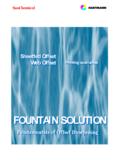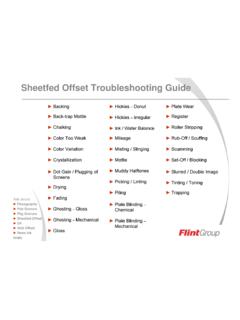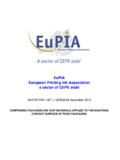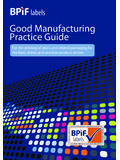Transcription of Information Note Swiss Ordinance 817.023.21 on …
1 Page 1 of 2. Information Note Swiss Ordinance on Materials and Articles in Contact with Food The 2008 revision of the Swiss Ordinance on Materials and Articles in Contact with Food ( Swiss Bedarfsgegenst ndeverordnung ) introduced new provisions for food packaging inks and printed food packaging (section 8b). While the Ordinance came already into force on 1st April 2008, the requirements will apply as from 1st April 2010, after a transitional period of two years1. Article 26g is introducing the obligations for packaging inks to be manufactured only from positive lists as outlined in Annex 6 (lists I - V) as well as annex 1 (lists I and II).
2 Articles 26i (1) and 26i (2) apply to printed layers and to the final packaging. Art. 26i(1) states that, under normal or foreseeable conditions of use, the printed layers may only release the substances contained therein to food in quantities which do not: - endanger human health; or - bring about an unacceptable change in the composition of the food; or - bring about deterioration in the organoleptic characteristics thereof. Art. 26i(2) states that migration of substances from the printed layers must meet the thresholds set out in the positive lists. The consequences for the packaging chain partners are as follows: Printing ink manufacturers - Positive Lists eupia member companies had undertaken every conceivable effort to ensure that ALL the raw materials currently used in their food packaging inks have been included in the positive list of the Swiss Ordinance .
3 This activity has been supported by eupia . For proprietary raw materials, as well as for monomers of binders and additives, eupia member companies contacted relevant suppliers and requested that those substances were likewise included into the Swiss Ordinance . However, since this 1. Ordinance on Materials and Articles in Contact with Food, Verordnung des EDI vom 7. M rz 2008 (AS 2008. 1061) , SR ;. for the German version, for the French version, for the Italian version Avenue E. Van Nieuwenhuyse 6 - BE-1160 Brussels Tel: +32 (0)2 676 7480 - Fax: + 32 (0)2 676 7490 - E-mail: - Internet: Page 2 of 2. process was managed via an independent trustee and was only closed at the end of last year, eupia member companies are, for the time being, not yet in a position to establish direct link for some of these raw materials with the positive lists.
4 Consequently, eupia member companies are in the process of requesting formal assurance from relevant suppliers. It is inevitable that this will take some time for all such Information to be gathered. Therefore, eupia member companies cannot assure full completion before the 1st April 2010, but anticipate no major problems in the supply of existing products. - Migration limits All substances of the eupia submission have been subdivided by the Swiss Federal Office of Public Health (FOPH) into sublists, which are: I) resins (monomers), II). colorants and pigments, III) solvents (including energy curing monomers ECM), IV). list of additives and V) list of photoinitiators.
5 Each of these has been further subdivided into Part A (= evaluated substances with migration limits) and Part B (=. non-evaluated substances with a migration threshold of 10 ppb). However, to date there is evidence that there are considerable inconsistencies in the allocation of substances into the part A or B. In fact the Swiss authorities themselves have acknowledged certain pending work that remains open for future discussion. Printer/converter and packer/filler As the printing ink manufacturers have no control over the packaging structure, design and converting process, the ultimate verification of compliance can therefore only be done on the finished printed and/or varnished food packaging.
6 The manufacturer of the final article has the legal responsibility to ensure that it is fit for the intended purpose and for the compliance with the Swiss Ordinance on Materials and Articles in Contact with Food. This includes the responsibility to comply with the relevant migration thresholds defined for Part A substances ( Specific Migration Limit SML), as well as for Part B substances (general limit of 10 ppb). eupia , 19 February 2010. Avenue E. Van Nieuwenhuyse 6 - BE-1160 Brussels Tel: +32 (0)2 676 7480 - Fax: + 32 (0)2 676 7490 - E-mail: - Internet.







